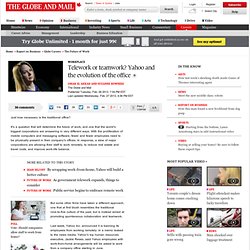

Engineering Serendipity. Photo WHEN Yahoo banned its employees from working from home in February, the reasons it gave had less to do with productivity than serendipity.

“Some of the best decisions and insights come from hallway and cafeteria discussions, meeting new people, and impromptu team meetings,” explained the accompanying memo. The message was clear: doing your best work solo can’t compete with lingering around the coffee machine waiting for inspiration — in the form of a colleague — to strike. That same day, Google provided details of its new campus in Mountain View, Calif., to Vanity Fair. Buildings resembling bent rectangles were designed, in the words of the search giant’s real estate chief, to maximize “casual collisions of the work force.” Silicon Valley is obsessed with serendipity, the reigning buzzword at last month’s South by Southwest Interactive Festival. As Yahoo and Google see it, serendipity is largely a byproduct of social networks.
Whereas Mr. Dr. The pleasures and perils of the open-plan office. 27 March 2013Last updated at 20:26 ET By William Kremer BBC World Service They can be noisy and distracting or depressingly quiet, and frictions with co-workers are guaranteed - so why do so many of us continue to work in open-plan offices?

In the spring of 1962, a fourth-year British architectural student was tasked with sketching an office layout. In the course of his research, Frank Duffy stumbled across a small article in a trade magazine about a new workplace design that had taken hold in Germany. Accompanying the article was a curious photograph. "The arrangement of the desks was somehow organic," Duffy recalls. The office in the photograph was open-plan, but it was a world away from the open-plan offices with which everyone was then familiar. Quickborner's plan for Osram's Munich office, 1965 (photo at top of page) These had arrived about a century earlier, when architects had started to use cast-iron girders to open up larger spaces within a building.
Continue reading the main story.
Telework or teamwork? Yahoo and the evolution of the office. Just how necessary is the traditional office?

It’s a question that will determine the future of work, and one that the world’s biggest corporations are answering in very different ways. With the proliferation of mobile computers and messaging software, fewer and fewer employees need to be physically present in their company’s offices. In response, a slew of major corporations are allowing their staff to work remotely, to reduce real estate and travel costs, and improve work-life balance. But some other firms have taken a different approach, one that at first blush resembles the traditional nine-to-five culture of the past, but is instead aimed at promoting spontaneous collaboration and teamwork.
Last week, Yahoo Inc. announced it is banning its employees from working remotely. “Some of the best decisions and insights come from hallway and cafeteria discussions, meeting new people, and impromptu team meetings,” the memo obtained by All Things Digital, read. Today, Mr. The six ways Generation Y will transform the workplace. More than 12 million strong and representing more than one-third of Canada’s population, Generation Y is the largest demographic cohort to come after the baby boomers.

Born between 1981 and 2000, members of Generation Y, also known as millennials, are already stirring things up in the workplace, according to their boomer bosses. After just a few years in the labour market, millennials have earned a reputation for being lazy, unprofessional, entitled “digital natives” who expect to start as interns on Monday and be chief executive officers by Friday. Those are the stereotypes, anyway. The reality? Gen Y is the most educated and most diverse generation in history, and the first to have more women than men obtain postsecondary education credentials. Whether boomers like it or not, Gen Y will continue to transform the workplace to better suit their needs. In just 15 years, by 2028, the last of the boomers will be reaching retirement age and leaving the labour market.
Voicemail, email, sitting, and meetings are dead. In Defense of Telecommuting. For 20-Somethings, Ambition at a Cost.